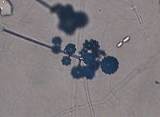
Cunninghamella
Encyclopedia
Cunninghamella is a genus of fungus in the Mucorales
order, and the family Cunninghamellaceae. Members of this genus are often used in studies investigating the metabolism of drugs, because these species metabolize a wide range of drugs in manners similar to mammalian enzyme systems. Many species are also capable of oxidizing polycyclic aromatic hydrocarbons, a class of stable organic molecules that tends to persist in the environment and contains many known carcinogen
ic and mutagen
ic compounds.
It can grow on Sabouraud's agar.
Mucorales
The Mucorales is the largest and best studied order of Zygomycete fungi. Members of this order are sometimes called pin molds.-Systematics:...
order, and the family Cunninghamellaceae. Members of this genus are often used in studies investigating the metabolism of drugs, because these species metabolize a wide range of drugs in manners similar to mammalian enzyme systems. Many species are also capable of oxidizing polycyclic aromatic hydrocarbons, a class of stable organic molecules that tends to persist in the environment and contains many known carcinogen
Carcinogen
A carcinogen is any substance, radionuclide, or radiation that is an agent directly involved in causing cancer. This may be due to the ability to damage the genome or to the disruption of cellular metabolic processes...
ic and mutagen
Mutagen
In genetics, a mutagen is a physical or chemical agent that changes the genetic material, usually DNA, of an organism and thus increases the frequency of mutations above the natural background level. As many mutations cause cancer, mutagens are therefore also likely to be carcinogens...
ic compounds.
It can grow on Sabouraud's agar.
Species
The genus Cunninghamella contains 16 species:- C. bainieri
- C. bertholletiaeCunninghamella bertholletiaeCunninghamella bertholletiae is a species of Cunninghamella.It can cause human disease....
- C. binarieae
- C. blakesleeana
- C. clavata
- C. echinulata
- C. elegans
- C. homothallica
- C. intermedia
- C. multiverticillata
- C. phaeospora
- C. polymorpha
- C. septata
- C. A18
- C. CL023
- C. vesiculosa

